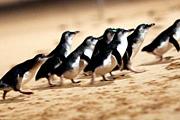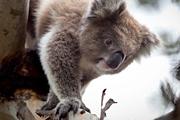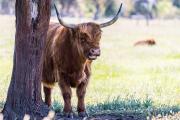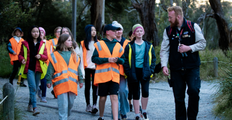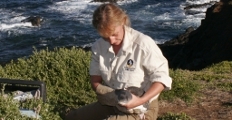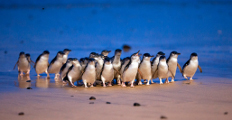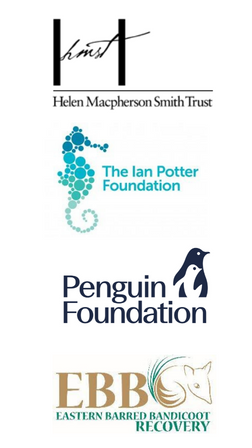Report Eastern Barred Bandicoot Sightings
Have you seen an Eastern barred bandicoot on Phillip Island (Millowl)? If so, we'd love to hear about it!
Phillip Island - Saving Eastern Barred Bandicoots
There are two subspecies of Eastern barred bandicoot (EBB), one that calls Tasmania home, and one that lives on the mainland. And until recently, the mainland Eastern barred bandicoot was declared extinct in the wild. But through the hard work of some dedicated conservation teams, the mainland Eastern barred bandicoot is back from the brink.
Eastern barred bandicoots live a solitary, secretive life foraging in open grasslands at night and resting in a shallow, cryptic nest during the day, usually in areas containing trees or shrubs. They are difficult to spot and the only sign of their presence is their small foraging digs.
Sadly, while they could originally be found all over South Australia and Victoria, their numbers declined rapidly due to European settlement. Most of their population loss was due to the loss of native grasslands, and because of introduced predators such as foxes. Due to these massive losses, the Eastern barred bandicoot was eventually declared as extinct in the wild. However, dedicated teams set out to make a difference, and their work saved a species.
Watch a VIDEO of the release here.
Back from the Brink
Numerous groups got together to formulate the Eastern barred bandicoot (EBB) Recovery Team who executed a plan to help save the Eastern barred bandicoot. This included Conservation Volunteers Australia, Department of Environment, Land, Water and Planning (DELWP), National Trust of Australia (Victoria), Parks Victoria, Phillip Island Nature Parks, the University of Melbourne, Tiverton Rothwell Partnering and Zoos Victoria.
Together, this group captured 42 Eastern barred bandicoots from the wild and took them into captivity with Zoos Victoria in 1988. From these 42 animals, just 19 successfully contributed to the breeding program.
In initial efforts to return the Eastern barred bandicoot to the wild, eight reintroduction sites were established on the mainland. Of these eight sites, three are home to breeding bandicoots today, with others failing primarily due to predation by foxes. Maintaining fox free areas on the mainland is extremely expensive and time consuming so as an alternative the recovery team started looking at fox-free islands, such as Phillip Island, as an alternative.
Our Island Home
In 2015 a trial release of 20 Eastern barred bandicoots was conducted on Churchill Island, a small fox, cat and rabbit free Island off the north-east of Phillip Island. This trial served to evaluate the suitability of local conditions and to demonstrate to the community what they might expect from an EBB release on Phillip island. This population increased to approximately 120 individuals in 2 years and has stabilised around this number.
“The trial release on Churchill Island demonstrated that Eastern barred bandicoots can successfully establish in island environments and have positive impacts such as reduced soil compaction, and improved nutrient and water infiltration, with no observed negative effects, and has given us the confidence to release them on Phillip Island,” said Richard Hill, Chair of the Eastern Barred Bandicoot Recovery Team.
When Phillip Island's fox eradication program was declared a success in 2017 this provided the perfect home for the Eastern barred bandicoot. On Friday, 20 October 2017 researchers from Phillip Island Nature Parks, Zoos Victoria and the Eastern Barred Bandicoot Recovery Team released a total of 44 individuals onto the Summerland Peninsula, located at the western tip of Phillip Island. This area is well known as the site of major conservation activities over several years as it was rehabilitated from a former housing estate to a natural environment which is also home to a thriving colony of little penguins and migratory short-tailed shearwaters. Despite the population of local feral cats, the bandicoots are now doing very well living on Phillip Island.
Current Status
In 2021, the Eastern barred bandicoot was officially labelled as endangered, rather than extinct in the wild and the captive breeding program was ceased, an incredible feat for any species. There’s still plenty of work to be done, but the Nature Parks and the Eastern Barred Bandicoot Recovery Team are excited to make it happen.
Do you want to immerse yourself in the story of the Eastern barred bandicoot’s recovery? We’ve designed an interactive page, full of videos and timelines, to showcase the entire story behind this outstanding conversation achievement! Click here to check it out.
Further Information:
Download the Eastern barred bandicoot Nature Notes here.
Phillip Island Nature Parks acknowledges the generous funding support provided by the Helen Macpherson Smith Trust for the EBB program, and from the Ian Potter Foundation and Penguin Foundation for the Fox Eradication Program.
The Eastern Barred Bandicoot Recovery Team includes representatives from (in alphabetical order): Conservation Volunteers Australia, Department of Environment, Land, Water and Planning (DELWP), Mt Rothwell Biodiversity Interpretation Centre, National Trust of Australia, Parks Victoria, Phillip Island Nature Parks, the University of Melbourne, Tiverton Property Partnering and Zoos Victoria.





